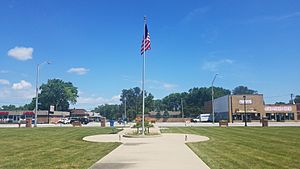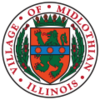Midlothian, Illinois facts for kids
Quick facts for kids
Midlothian, Illinois
|
|||||
|---|---|---|---|---|---|

A view of the US flag and 147th Street, in Downtown Midlothian.
|
|||||
|
|||||
| Nickname(s):
The community that pride built
|
|||||

Location of Midlothian in Cook County, Illinois.
|
|||||
| Country | |||||
| State | Illinois | ||||
| County | Cook | ||||
| Township | Bremen | ||||
| Incorporated | March 17, 1927 | ||||
| Named for | Midlothian, Scotland | ||||
| Government | |||||
| • Type | Mayor/Board of Trustees | ||||
| Area | |||||
| • Total | 2.82 sq mi (7.30 km2) | ||||
| • Land | 2.82 sq mi (7.30 km2) | ||||
| • Water | 0.00 sq mi (0.00 km2) 0% | ||||
| Population
(2020)
|
|||||
| • Total | 14,325 | ||||
| • Density | 5,081.59/sq mi (1,961.84/km2) | ||||
| Demonym(s) | Midlothianite | ||||
| Standard of living (2007-11) | |||||
| • Per capita income | $22,945 | ||||
| • Median home value | $100,000 | ||||
| ZIP code(s) |
60445
|
||||
| Area code(s) | 708 | ||||
| Geocode | 48892 | ||||
| FIPS code | 17-48892 | ||||
Midlothian (pronounced mid-LOW-thee-an) is a village in Cook County, Illinois, United States. It's a suburb located southwest of Chicago. In 2020, about 14,325 people lived there.
Contents
History of Midlothian

In the 1800s, the area that is now Midlothian was mostly farmland. It was part of Bremen Township in Cook County. As industries grew, things started to change.
By 1854, a railroad track was built through the area. This track connected Chicago and Joliet. It was part of the Chicago, Rock Island and Pacific Railroad. This made it easier to travel and move goods.
A gunpowder factory called DuPont was once in the area. In 1906, there was a big explosion at the factory. The shockwaves were so strong they broke windows at the Midlothian Country Club. Later, part of the DuPont property became the Midlothian Meadows Forest Preserve. This is now part of the Cook County Forest Preserve system.
Early Transportation and Development
The roads in the area were mostly dirt roads. When it rained, they became very muddy and hard to use. This made it difficult to deliver goods and services. Wealthy members of the Midlothian Country Club found this inconvenient.
They decided to create their own railroad. It was called the Midlothian - Blue Island Railroad. They wanted to lay tracks from Blue Island right to the country club. Instead of building a whole new line, they worked with the Chicago-Rock Island Railroad. They built a short track from Rexford Crossing to the club.
A train station was built at Rexford Crossing and renamed "Midlothian." This station became part of the downtown area. The Midlothian - Blue Island Railroad owned the tracks and trains. The Chicago, Rock Island and Pacific Railroad owned the station building.
Becoming a Village
For a long time, Midlothian remained mostly farms and forests. The train station didn't bring much new business. People mostly farmed, harvested limestone, and made gunpowder.
The Midlothian Fire Department started in 1924. This might have been to prepare for the village to become official. In 1927, residents voted to establish the Village of Midlothian. It was officially incorporated on March 17, 1927. The village likely took its name from the train station.
After the village was formed, the Midlothian - Blue Island Railroad tracks were removed in 1928. This left Midlothian with one main train line. In 1929, Midlothian got its first newspaper, The Messenger.
In the 1930s and 1940s, more homes were built. Businesses like the Kreis Brothers Ford Garage and Chuck Cavallini's "Sweet Shop" opened. In 1949, a Village Hall was built. This building still houses village offices, including the police and fire departments.
Geography and Nature
Midlothian is located in the South Suburbs of Chicago. It is part of the Bremen Township. The village covers about 2.82 square miles (7.30 square kilometers) of land.
Midlothian is home to the Midlothian Meadows, a Cook County Forest Preserve. It also has a popular sledding spot called Belly Button Hill. Two creeks, Natalie Creek and Midlothian Creek, run through the area.
Climate in Midlothian
Like most of Cook County, Midlothian has warm summers. Winters can be very cold.
| Climate data for Midlothian, Illinois | |||||||||||||
|---|---|---|---|---|---|---|---|---|---|---|---|---|---|
| Month | Jan | Feb | Mar | Apr | May | Jun | Jul | Aug | Sep | Oct | Nov | Dec | Year |
| Mean daily maximum °F (°C) | 30 (−1) |
35 (2) |
46 (8) |
59 (15) |
70 (21) |
80 (27) |
84 (29) |
82 (28) |
75 (24) |
63 (17) |
48 (9) |
35 (2) |
59 (15) |
| Mean daily minimum °F (°C) | 14 (−10) |
18 (−8) |
28 (−2) |
39 (4) |
49 (9) |
59 (15) |
64 (18) |
62 (17) |
55 (13) |
42 (6) |
32 (0) |
21 (−6) |
40 (5) |
Population and People
In 2020, Midlothian had 14,325 residents. There were 5,828 households and 3,786 families. The population density was about 5,081 people per square mile.
The people living in Midlothian come from many different backgrounds. In 2020, about 55.60% of residents were White, 13.49% were African American, and 32.15% were Hispanic or Latino. Many people in Midlothian are from two or more racial groups.
About 22.3% of the population was under 18 years old. The average age in the village was 39.7 years. The median income for a household was $61,067. This means half of the households earned more than this, and half earned less.
| Historical population | |||
|---|---|---|---|
| Census | Pop. | %± | |
| 1930 | 1,775 | — | |
| 1940 | 2,430 | 36.9% | |
| 1950 | 3,216 | 32.3% | |
| 1960 | 6,605 | 105.4% | |
| 1970 | 14,422 | 118.3% | |
| 1980 | 14,274 | −1.0% | |
| 1990 | 14,372 | 0.7% | |
| 2000 | 14,315 | −0.4% | |
| 2010 | 14,819 | 3.5% | |
| 2020 | 14,325 | −3.3% | |
| U.S. Decennial Census | |||
Arts and Culture
Midlothian is known for its annual Fiesta. This event is held at the St. Augustine Catholic Church. It takes place at 147th & Keeler.
Parks and Recreation
Midlothian has several parks where you can enjoy outdoor activities:
- Kostner Park
- Roesner Park
- Bremen Heights Park
- Waverly Park
- Memorial Park
- Scout Park
Transportation and Infrastructure
Midlothian is known for its train station, the Midlothian station. This station offers Metra commuter rail service. You can take trains north to LaSalle Street Station in Chicago. You can also travel south to Joliet Transportation Center.
Pace also provides bus service in Midlothian. These buses connect the village to many other places in the Southland area. The village is also close to major highways like the Tri-state Tollway (I-294) and I-57.
Notable People from Midlothian
- Gary Bettenhausen - a famous auto racer
- John Coyne - a novelist
- Don A. Moore - an Illinois judge, lawyer, and politician
- Johnny Mostil - an outfielder for the Chicago White Sox baseball team
- Ken Wahl (Anthony Calzaretta) - a film and television actor, known for Wiseguy
See also
 In Spanish: Midlothian (Illinois) para niños
In Spanish: Midlothian (Illinois) para niños







